Communicating water words and visuals
Making sense of the terminology
Contact
For more information, visit the project page
Introduction
Research suggests that communication techniques combining engaging visuals and easy-to-understand terminology can build support for new policies.
This webpage summarises the findings from the project Engaging communities with water sensitive cities (A2.3) research on “water words and visuals”. It provides help to those who need to communicate about water-related issues to develop effective water-related communication materials. The sections below capture the take home messages when developing communications about water: through water words, and water visuals.
Whether you are designing information for outward facing communications (e.g. website, fact sheets), planning for community consultation, having informal conversations with community members or even talking to politicians, the findings of A2.3 research could help to more fully engage audiences with water information.
You can read about the research in more detail in:
Topics
Pathways
Water words
This information provides communicators with recommendations of when to use these words and when an explanation is necessary. This web feature only includes terminology that was tested within the project.
Stormwater pollution
Take home message: Although a majority of people know that stormwater flows can damage waterways, only around a third know that stormwater doesn’t get treated before entering waterways.
Recommendations for use
When people think about stormwater, they think of flooding rather than pollution. It’s important to provide specific information about pollutants, especially those that are invisible.
Alternative words
Rainwater pollution or polluted runoff were used by community members.

There is low understanding of this term - 31% of survey respondents understood the term well or very well.
Did you know?

69% of Australians know that waterways can be damaged by stormwater flows

54% of Australians understand that waterways cannot easily cope with large amounts of sediment

32% of Australians know that stormwater is not treated before entering waterways
Biofiltration
Take home message: That only a third of people know that stormwater doesn’t get treated before entering waterways suggests that people may not understand the need for biofiltration. In addition to an explanation of the term, it may be important to also communicate the reasons why biofiltration is needed.
Recommendations for use
People report knowing very little about water sensitive urban design options and point to the need to ‘see’ the benefits that they generate.
Alternative words
community members use for biofiltration include natural filtration, biopurification, and biocleaning.

There is very low understanding of this term - 10% of survey respondents understood the term well or very well.
Did you know?

69% of Australians know that waterways can be damaged by stormwater flows

54% of Australians understand that waterways cannot easily cope with large amounts of sediment

32% of Australians know that stormwater is not treated before entering waterways
Raingarden
Take home message: People report little knowledge of water sensitive urban design and terms such as raingarden. After receiving a description of a raingarden (i.e. raingardens in parks absorb water and filter out pollutants), just over half of people said they would support installation of a raingarden in their street, but only just over a third would be willing to install one on their property. Strategies to promote support for public and private raingardens may be needed alongside explanations of what raingardens are and what they do.
Recommendations for use
People report knowing very little about water sensitive urban design options and point to the need to ‘see’ the benefits that they generate.

There is low understanding of this term - 12% of survey respondents understood the term well or very well.
Did you know?

56% of Australians would support the installation of raingarden in their street

37% of Australians would be willing to install a raingarden on their property

32% of Australians know that stormwater is not treated before entering waterways
Riparian
Take home message: Very few people understand this term, but a majority do understand that planting native trees along waterways is good for waterway health.
Alternative words are definitely needed here, or otherwise, accompany the term “riparian” with an explanation.

There is very low understanding of this term – 7% of survey respondents reported understanding the term well or very well.
Did you know?

68% of Australians know that planting native plants along a waterway’s bank improves the health of waterways
Urban heat island effect
Take home message: This term should be used with caution and always accompanied by an explanation.
Alternative words community members use for urban heat island effect include city climate, city heat, and inner city warming.

There is very low understanding of this term – 7% of survey respondents reported understanding the term well or very well.
Decentralised water supply
Take home message: Peoples’ understanding of water supply and treatment is mixed: just over 50% say they know where their drinking water comes from, but fewer know that wastewater is treated before being released to waterways, or that stormwater is not treated before being released into waterways. Examples of decentralised water supplies may be an important part of any explanation.
Alternative words community members use for decentralised water supply include localised water supply, non-mains water, neighbourhood water supply, and shared water assets.

There is low understanding of this term – 12% of survey respondents reported understanding the term well or very well.
Did you know?

56% of Australians say they know where their drinking water comes from

28% of Australians know that wastewater receives treatment before entering waterways

32% of Australians know that stormwater is not treated before entering waterways
Treatment wetlands
Take home message: It may be relatively easy to communicate the logic for treatment wetlands, because a majority of people know that pesticides have a negative impact on waterway health. However, people understand little about how stormwater is currently handled: only a minority know that stormwater is not treated before entering waterways, and that wastewater and stormwater are carried through separate pipes.

There is low understanding of this term – 12% of survey respondents reported understanding the term well or very well.
Did you know?

59% of Australians know that pesticides from household gardens can have a negative impact on the health of waterways

32% of Australians know that stormwater is not treated before entering waterways
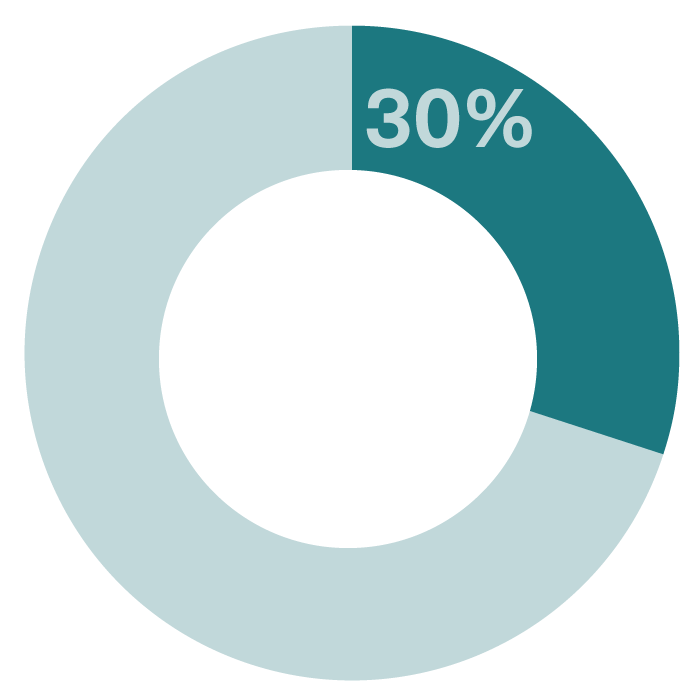
30% of Australians know that wastewater and stormwater are carried through separate pipe
Tips for practice
- People report knowing very little about water sensitive urban design options and point to the need to understand and ‘see’ the benefits that they generate.
- People are positive about water sensitive urban options when they are shown and explained to people.
Water sensitive
Take home message: A common alternative people use is ‘waterwise’. A good explanation needs to accompany the use of this term until it attains the same recognition as waterwise.
Recommendations for use
- Some community members find this term off-putting. Avoid relying on this term in brief communication outputs (such as headings or short flyers).
- When using ensure the term is explained adequately.
Alternative words community members use for water sensitive city include waterwise city, ecocity, water friendly, and water conscious.

There is low understanding of this term – 16% of survey respondents reported understanding the term well or very well.
Total water cycle management
Take home message: People generally demonstrate a mixed understanding of water management. A majority know that household water conservation can reduce water demand in urban areas, but a minority understand that the amount of water available for use is often finite. In addition, only a minority know that stormwater and wastewater are carried through separate pipes.

There is low understanding of this term – 14% of survey respondents reported understanding the term well or very well.
Did you know?

74% of Australians know that water conservation actions by householders can reduce the amount of water used in urban areas

30% of Australians know that stormwater and wastewater are not carried through the same pipes
Fit for purpose
Take home message: People seem to know little about water treatment: a minority understand that wastewater is treated before entering waterways whereas stormwater is not.
Alternative words community members use for fit for purpose include water for purpose, and purpose specific water treatment.

There is low understanding of this term – 17% of survey respondents reported understanding the term well or very well.
Did you know?

28% of Australians know that wastewater is treated before entering waterways

32% of Australians know that wastewater is not treated before entering waterways
Green infrastructure
Take home message: People report little knowledge of water sensitive urban design, but the logic for green infrastructure may be relatively straightforward to communicate because a majority of people know that stormwater flows and soil erosion can affect the health of waterways.
Recommendations for use
- People report knowing very little about water sensitive urban design options and point to the need to understand and ‘see’ the benefits that they generate.
- People are positive about water sensitive urban options when they are shown and explained to people.

There is low understanding of this term – 14% of survey respondents reported understanding the term well or very well.
Did you know?

69% of Australians know that waterways can be damaged by stormwater flows

61% of Australians know that soil erosion from urban areas affects the health of waterways
Microclimate
Take home message: This term should be explained any time it is used.
Alternative words community members use for microclimate include localised environment, mini climate, and local conditions.

There is low understanding of this term – 16% of survey respondents reported understanding the term well or very well.
Catchment
Take home message: Communicators should not assume people understand this commonly used term. Fewer than 50% of respondents correctly identified the definition of a catchment, or reported knowing which catchment their household falls in.

There is a reasonable understanding of this term – 44% of survey respondents reported understanding the term well or very well.
Did you know?

46% of Australians correctly identified the definition of a catchment

39% of Australians report knowing what catchment their household is part of
Waterwise
Take home message: There is reasonable understanding of this term, which aligns with data showing that a majority know that conserving water in the home can reduce urban water demand. Explanations of how to be waterwise are one way to further communicate this concept.

There is a reasonable understanding of this term – 44% of survey respondents reported understanding the term well or very well.
Did you know?

74% of Australians know that water conservation actions by householders can reduce the amount of water used in urban areas
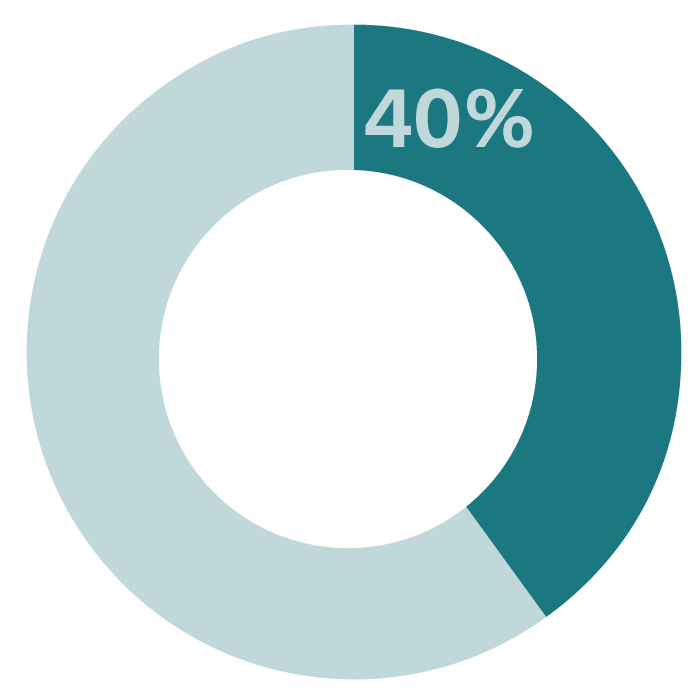
40% of Australians know that the amount of water available for use is finite
Sustainability
Take home message: A key aspect of sustainability is conservation of resources and a majority of people know that conserving water in the home helps to reduce water demand in urban areas. However, only a minority understand that the amount of water available for use is often finite (given that interventions such as desalination can be prohibitively expensive).

There is a reasonable understanding of this term – 49% of survey respondents reported understanding the term well or very well.
Did you know?

74% of Australians know that water conservation actions by householders can reduce the amount of water used in urban areas

40% of Australians know that the amount of water available for use is finite
Recycled water
Take home message: Current knowledge of water supply is mixed: a minority know that the amount of water available for use is typically finite, but a small majority report knowing where their drinking water comes from. Social research shows some people have a negative emotional reaction to recycled water, which is why water organisations around the world often use alternative terms for recycled water that emphasise the purity of the water after advanced treatment.
Recommendations for use
While community members understand this term, it may generate a negative emotional response in some individuals. Communication research recommends using terms that describe the state of the water (‘purified water’) rather than the source.
Alternative words community members use for recycled water include clean water, new water, purified water & reclaimed water.

There is relatively good understanding of this term - 62% of survey respondents reported understanding the term well or very well.
Did you know?

40% of Australians know that the amount of water available for use is finite

56% of Australians report knowing where their drinking water comes from
Water visuals
A traffic light system was used to evaluate the images on each of the dimensions. The images were assigned a green light (elicit positive emotions/high personal relevance/high topic relevance), an amber light (weak or neutral emotion/moderately personally relevant/moderately topic relevant) or a red light (negative emotion/not personally relevant/irrelevant to the topic). See below for more information about this evaluation process.
This information can be used by communicators to decide which images might work best to accompany information about water.
Traffic Light System |
Emotion |
Topic Relevance |
Personal Relevance |
 |
The image elicited strong positive emotions | The image is most relevant to the topic of stormwater management | The image is the most personally relevant |
 |
The image elicited weak or neutral emotions | The image is somewhat relevant to the topic of stormwater management | The image is somewhat personally relevant |
 |
The image elicited strong negative emotions | The image is the least relevant to the topic of stormwater management | The image is the least personally relevant |
- Green Infrastructure
- Traditional stormwater infrastructure
- Swales
- Images of rainwater tanks
- Images of pristine, inland bodies of water in rural settings
- Images of pristine ocean environments
- Images of ocean environments with plastic
- Images depicting flood events
- Images of flood clean-up activities
- People engaged in recreation activities
- Images depicting cityscapes
Green Infrastructure
This category of images included raingardens, treatment wetlands and greenwalls.
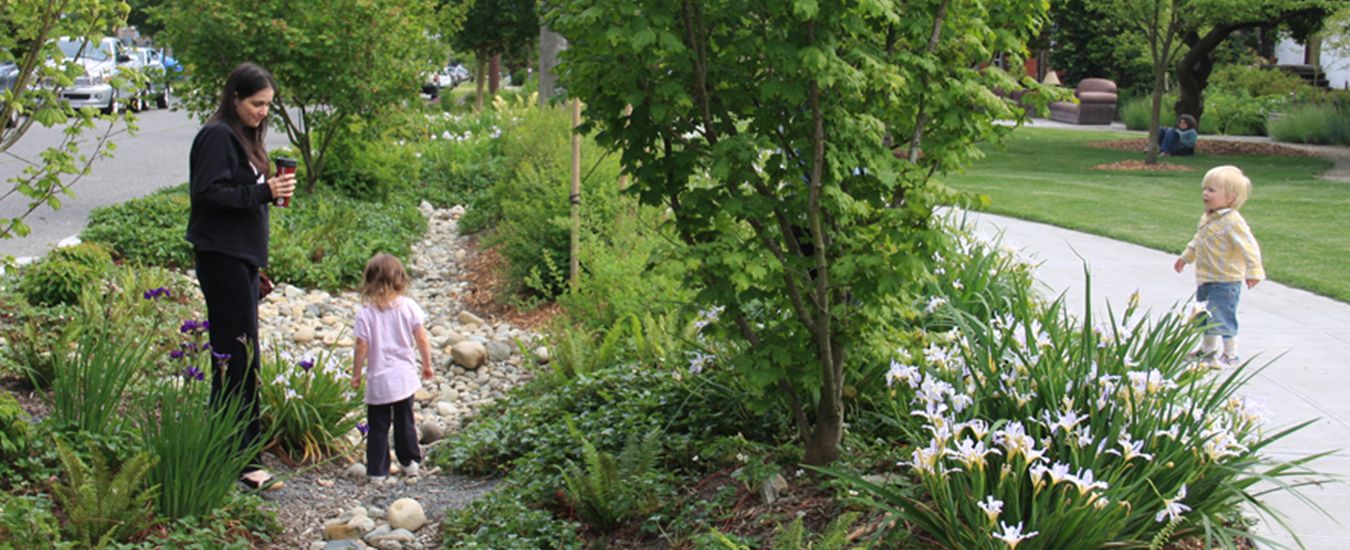
Elicited weak or neutral emotions

Whilst the images did not elicit negative emotions, they failed to elicit strongly positive emotions with most community members responding that they felt neutral about the images. The attractiveness of the infrastructure was important; the more attractive or ‘beautiful’ the infrastructure, the higher it was ranked.
“Getting towards neutral – these are just more it’s nice to be able to go for a walk in the urban space with different sort of uses of vegetation.”
Somewhat relevant to the topic

Community members failed to identify the purpose of green infrastructure with regard to minimising the impacts of stormwater on waterway health. Rather they felt that the relevance was related to rainwater keeping the plants watered and alive. Images that included a visible grate were ranked higher than other images.
“I just associate gardens with rain, and they need water”
Somewhat personally relevant

Images that were considered highly familiar or that included people were ranked higher.
“Looks like a new estate, don’t live in a new estate, but it’s familiar”
Recommendations for use:
- Use images of highly attractive green infrastructure, for example, raingardens that include flowers or bright green foliage
- Use images that include people interacting with the infrastructure to boost both the positive emotion and personal relevance of the image
- Explain the purpose of the infrastructure
Traditional stormwater infrastructure
This category of images included drains, outlets, pipes and gross pollutant traps.

Elicited strong negative emotions

The images elicited negative emotions like disgust and anger. Images that included visible rubbish elicited the most negative emotion.
“Unpleasant, because it’s a lot of rubbish trapped and it’s obviously there for that purpose. So the system is kind of working in that we have something in place to trap rubbish, but the rubbish is still there”
Most relevant to the topic

Out of all of the tested images, images of traditional stormwater infrastructure were ranked as being the most relevant to the topic of stormwater management.
“The ones that are most relevant are ones with drains”
“More of these ugly grids, cement, they’re an eye sore – very relevant.”
Least personally relevant

Images of traditional stormwater infrastructure were ranked amongst the least personally relevant.
“Rubbish in the gutter…I hate that…it’s least relevant to me because I do the right thing and encourage people to do the right thing”
Recommendations for use:
- Avoid the use of images that include visible pollution and rubbish that can elicit high levels of disgust
Swales
This category of images included swales, both vegetated and not.
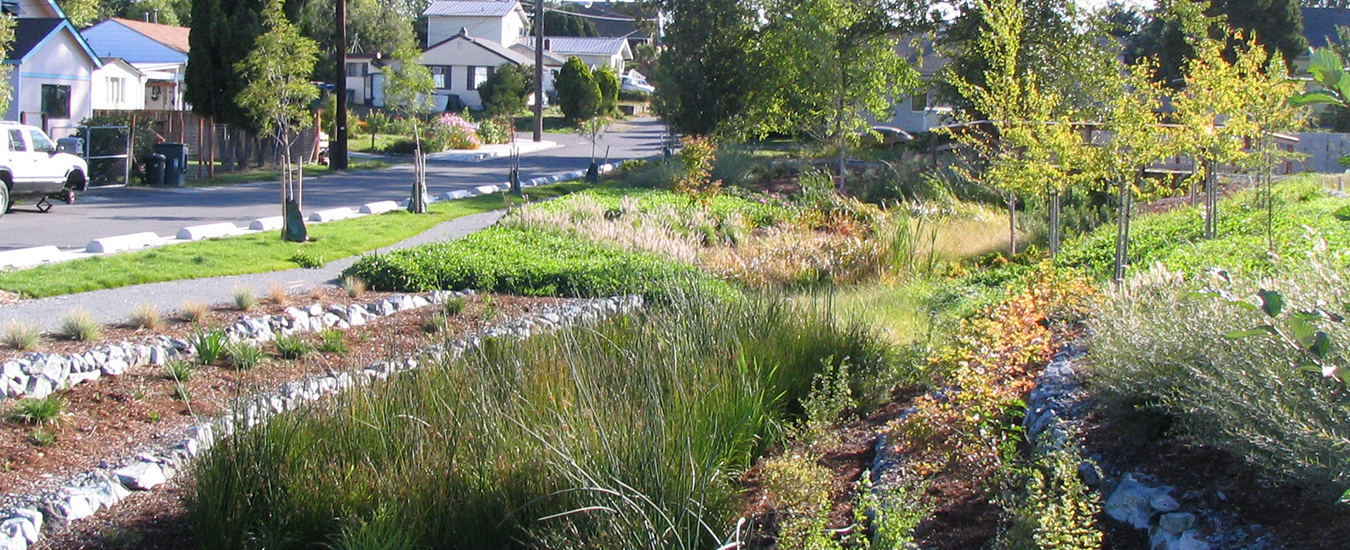
Elicited weak emotions

These images elicited either weak positive or weak negative emotions. For example, an image of a swale under construction elicited weak negative emotions. Whereas, a vegetated swale elicited weak positive emotions.
“It’s just a park in the suburbs”
“I feel nothing about it at all.”
Somewhat relevant to the topic

Despite being ranked towards the middle of the scale, most community members could identify the basic purpose of swales.
“Start of some sort of control measure to divert water”
Somewhat personally relevant

Images that were considered highly familiar were ranked higher.
“Shows urban setting, which does not resonate as strongly as natural settings”
“That’s a really familiar looking scene…I don’t know where it is but it’s quite familiar with the suburban area that I live in now”
Recommendations for use:
- Use images of well established, vegetated swales to boost the attractiveness and positive appeal of the image
- Use images of swales from popular, local parks to boost the personal relevance of the image
Images of rainwater tanks
This category of images included rainwater tanks located in suburban backyards.
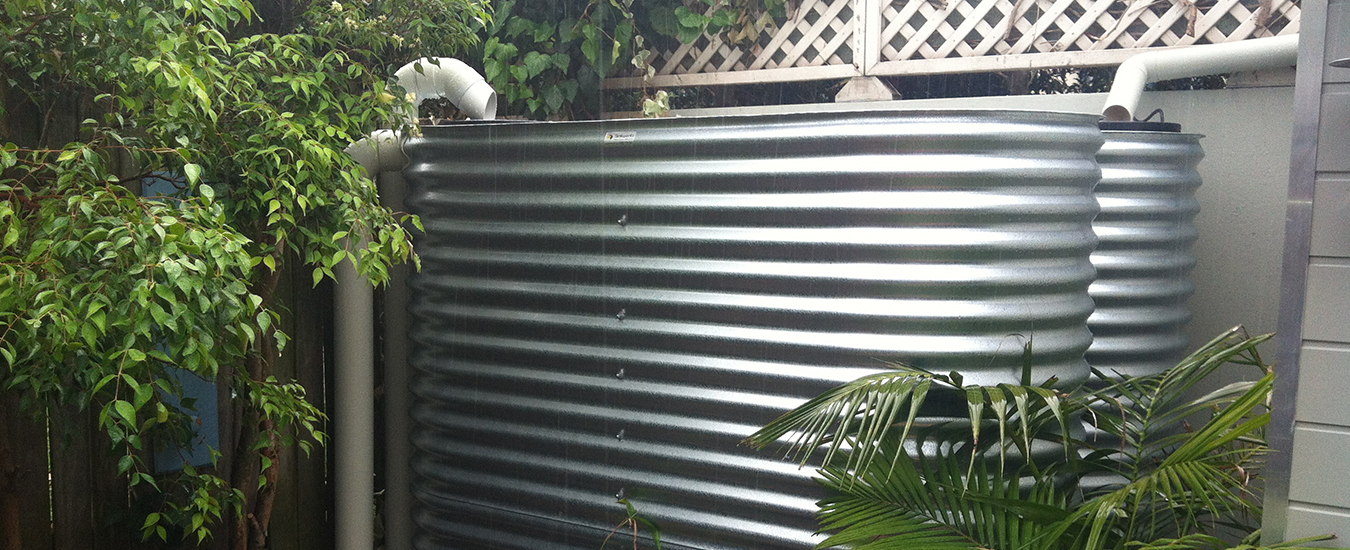
Elicited weak positive or neutral emotions

Images of rainwater tanks elicited weak positive emotional reactions, particularly for those members that owned rainwater tanks.
“It’s nice to see the rainwater tanks making a comeback”
“Great, but a more neutral response”
Somewhat relevant to the topic

Community members ranked the tanks as somewhat relevant to the topic and indicated that they understood the role of the water tank in capturing rainwater for alternative uses, such as watering the lawn.
“The link here is how to divert stormwater and use it for other purposes”
Somewhat personally relevant

The images fell at the mid-way point of the personal relevance scale, with those people that either had or desired a rainwater tank placing the images higher on the personal relevance scale.
“Not as relevant to me, we don’t have tanks”
“We put water tanks in because of the drought”
Recommendations for use:
- Use images that include people to boost both the positive emotion and personal relevance of the image
Images of pristine, inland bodies of water in rural settings
This category of images included inland creeks, rivers and dams. Some images included animals such as water dragons and swans.
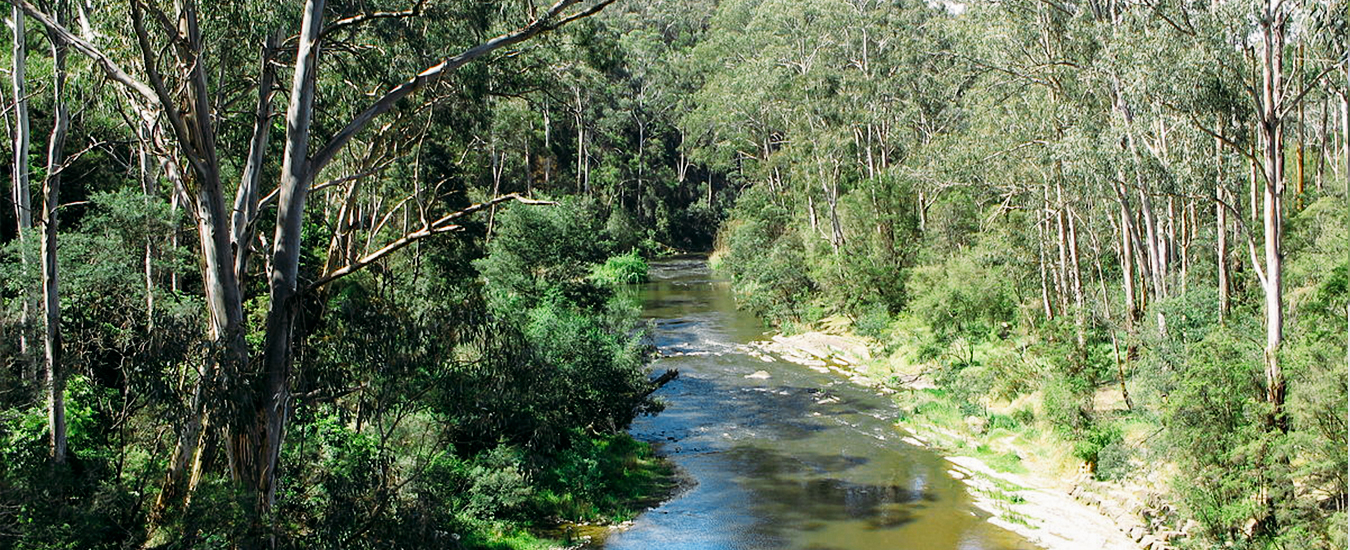
Elicited strong positive emotions

Community members had strong positive emotional reactions to the images. They elicited emotions like calmness and happiness. The highest ranked image from this category was of a small waterfall in a rainforest setting.
“It’s a peaceful creek in the bush and I like that”
Least relevant to the topic

The majority of respondents understood that rainfall eventually flows into rivers and creeks, however, the images were not ranked highly in terms of relevance to stormwater management in cities and towns. Some community members highlighted the distance from urban areas.
“Not as relevant because it’s showing more remote waterways - not as quickly or directly affected”
Somewhat personally relevant

Generally, the images were seen as somewhat personally relevant, with relevance tied to how familiar the image was. That is, the more familiar the image, the higher the personal relevance. In addition, images that included animals were ranked by half of the community members as highly personally relevant.
“[This image] triggers a camping memory”
“Just looks like a creek, pretty boring”
Recommendations for use:
- Use images that include animals to boost the personal relevance of the image.
- Explain the link between catchment health and stormwater management.
Images of pristine ocean environments
This category included images of pristine ocean environments including underwater shots of coral and aerial shots of islands, as well as images that included ocean animals such as turtles and dolphins.

Elicited strong positive emotions

The images elicited strong positive emotions for all community members and were amongst the highest ranked of all the tested images. Amongst the ocean images, an image of a turtle was given the highest score.
“Beautiful setting. Looks very relaxing. I’d like to be there”
“That’s what I love to see”
Least to most relevant to the topic

There was a discrepancy between community members in terms of topic relevance. The majority of respondents failed to identity the relevance of ocean imagery in terms of relevance to stormwater management and consequently they ranked the images as the least topic-relevant. A smaller sub-group ranked the images as highly topic relevant.
“The ocean’s always been around and I don’t necessarily associate it with stormwater”
“It’s relevant in the sense that it gets into the stormwater drains and then goes out to sea”
Varied personal relevance

The images received a mixed response with regard to personal relevance. Just over half of the community members scored the images highly for personal relevance, one-third of the community members had a neutral response to the images and a small number considered the images irrelevant.
“I grew up in North Queensland, so the coast and the environment are important to me”
“I am not a beach person, all these open ocean type images are not part of my normal experience”
Recommendations for use:
- Use images that include popular animals, turtles for example, to boost the personal relevance of the image.
- Explain the link between ocean health and stormwater management.
Images of ocean environments with plastic
These category included an image of a plastic bag floating in the ocean and an image of a turtle ingesting plastic.

Elicited strong negative emotions

Community members overwhelmingly reported that the images elicited sadness. Across all tested images, an image of a turtle ingesting plastic elicited the strongest negative emotional reaction.
“I want to cry when I look at that, it’s terrible, it shouldn’t happen”
Somewhat to least relevant to the topic

Consistent with the response to the images of pristine ocean environments, the images received a mixed response with regard to the relevance to the topic: a small proportion of community members identified that the images were highly relevant to the topic of stormwater management but the larger subgroup ranked the images below the mid-way point of the scale.
“Not as relevant because it’s showing more remote waterways - not as quickly or directly affected”
“It shouldn’t happen, and very important for stormwater management”
Varied personal relevance

The images received a mixed response with regard to personal relevance. Just over half of the community members scored the images highly for personal relevance, one-third of the community members had a neutral response to the images and a small number considered the images irrelevant.
“Is just plastic in the water, that talks to me more than anything. That upsets me very much. We could do something about it but we don’t”
“Least relevant – that is something you would see scuba diving which is something I have never done”
Recommendations for use:
- Explain the link between ocean health and stormwater management
Images depicting flood events
This category of images included flash flooding as well as aerial shots of Brisbane City in flood.
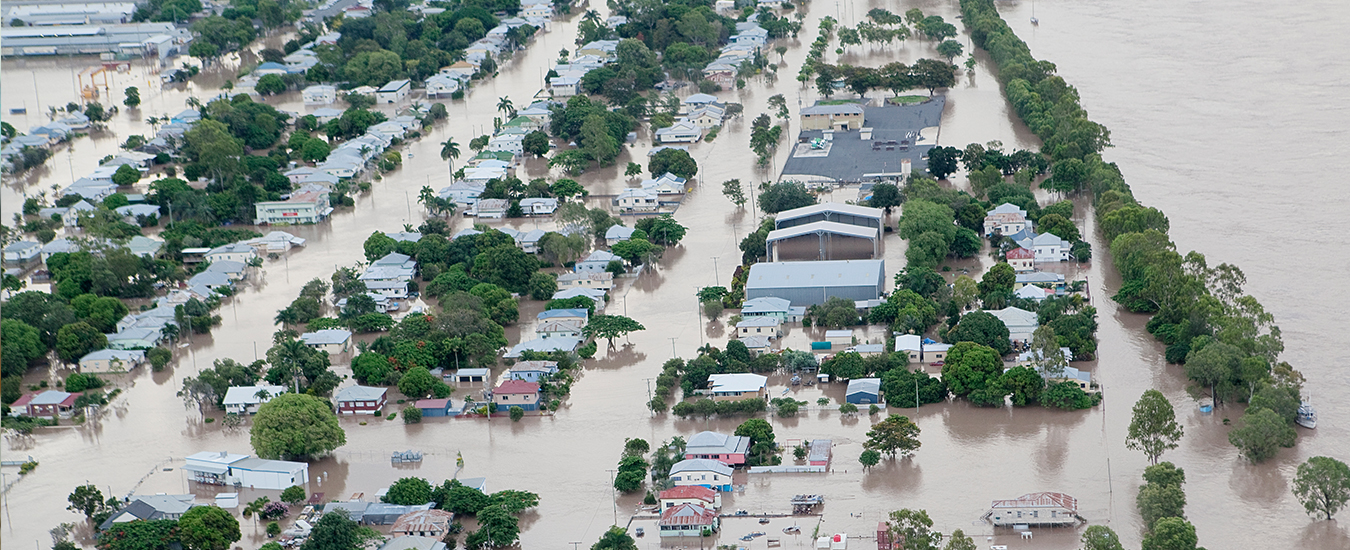
Elicited strong negative emotions

The images elicited the negative emotion of sadness.
“Flooding is no good for anybody, people lose so much through that, their homes, their memories, their photos, so it’s unpleasant”
Somewhat to most relevant to the topic

While the majority of community members indicated that the images were highly relevant to the topic of stormwater management, the smaller subgroup ranked the images as somewhat topic-relevant. This was because this subgroup of community members considered images of ocean environments as more important to the idea of stormwater management in cities and towns.
“That’s relevant in its own way”
“The floods are always going to happen here”
Somewhat personally relevant

The images were consistently ranked around the mid-way point of the scale with regard to personal relevance, with community members who had personally experienced a flood event ranking them higher than other community members.
“Got caught in the floods, pretty relevant”
“Very impactful, not to myself personally but brings back that kind of memory”
Recommendations for use:
- Use images of flood events that would be familiar to your target audience to boost the personal relevance of your message.
Images of flood clean-up activities
This category of images included people cleaning up after flood events.
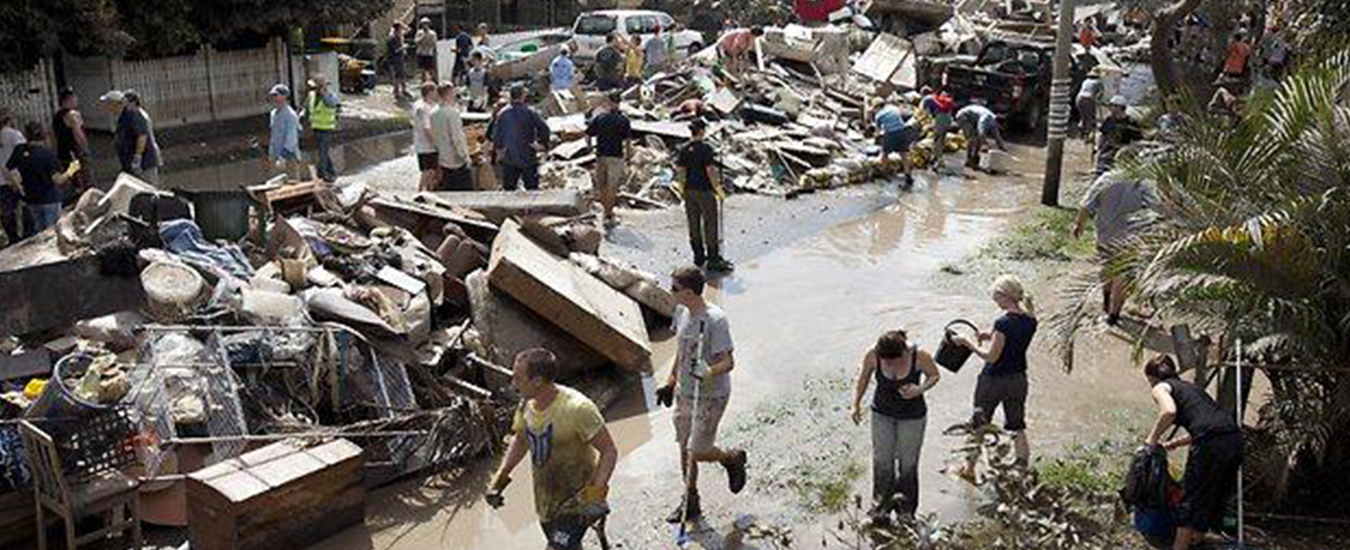
Elicited weak to strong positive emotions

The majority of the community members ranked these images highly with regard to positive emotion, as they elicited pride and belonging. However, a small sub-set of the community members ranked the images around the mid-way point of the emotion scale. They indicated that they felt somewhat sad or disappointed that people needed to clean-up due to either a flood event or human pollution.
“It’s great how the community comes together when it’s needed”
“Makes me feel pretty sad about all that”
Somewhat relevant to the topic

Despite receiving scores in the mid-range of the scale, community members indicated that they understood the relevance of these images with regard to stormwater and flooding.
“Here is people tiding up after, picking up things that have washed down after flood”
“Not sure if they are exactly stormwater related or just caring for waterways related”
Highly personally relevant

Across all tested images these were ranked as the most personally relevant.
“I like these because at least they are trying to do something”
Recommendations for use:
- Use images of flood events that would be familiar to your target audience to boost the personal relevance of your message.
People engaged in recreation activities
This category of images included people engaged in water activities such as surfing, boating and fishing, as well as images of people alongside waterways.
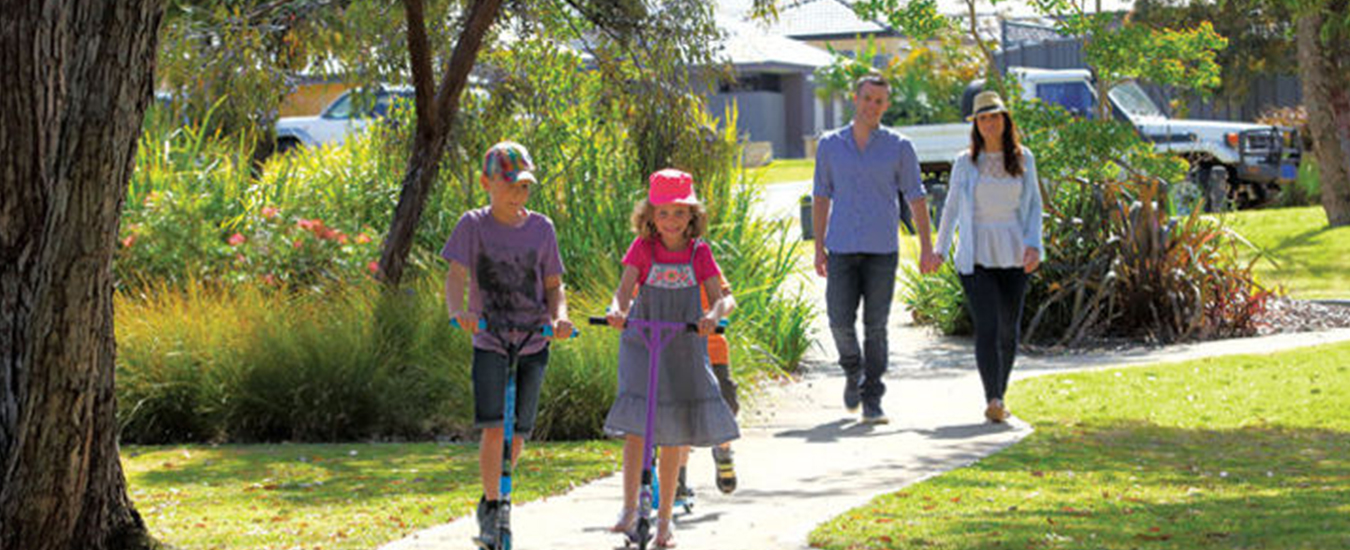
Elicited strong positive emotions

These images consistently elicited positive emotions, largely tied to community members' happiness to see people enjoying the outdoors. Activities like biking and walking were ranked higher as these activities appeal to a wider range of community members.
“Strong connection, I’ve walked up and down that little stretch of bikeway many many times”
“I like the people paddling in natural sort of setting, in a natural way”
Least relevant to the topic

These images were consistently ranked at the bottom of the scale in terms of topic relevance.
“Not really relevant – more about leisure time”
“Not relevant to stormwater”
Somewhat to highly personally relevant

It was extremely rare to have a group of images whereby the large majority sat above the mid-way point on the personal relevance dimension, as was the case for this category. An image of a bike rider along the Brisbane River was one of the highest ranked images with regard to personal relevance across all tested images.
“Very relevant to me as I ride along the bike track”
“Recreation is important to me”
“Boating is not something I am interested in”
Recommendations for use:
- Use images with people in them to boost the personal relevance of your message.
- Explain the link between the image and stormwater management.
- Use popular recreation activities like walking and biking to further boost the positive appeal and personal relevance of the image.
Images depicting cityscapes
This category included images of the Brisbane city skyline with the Brisbane River.
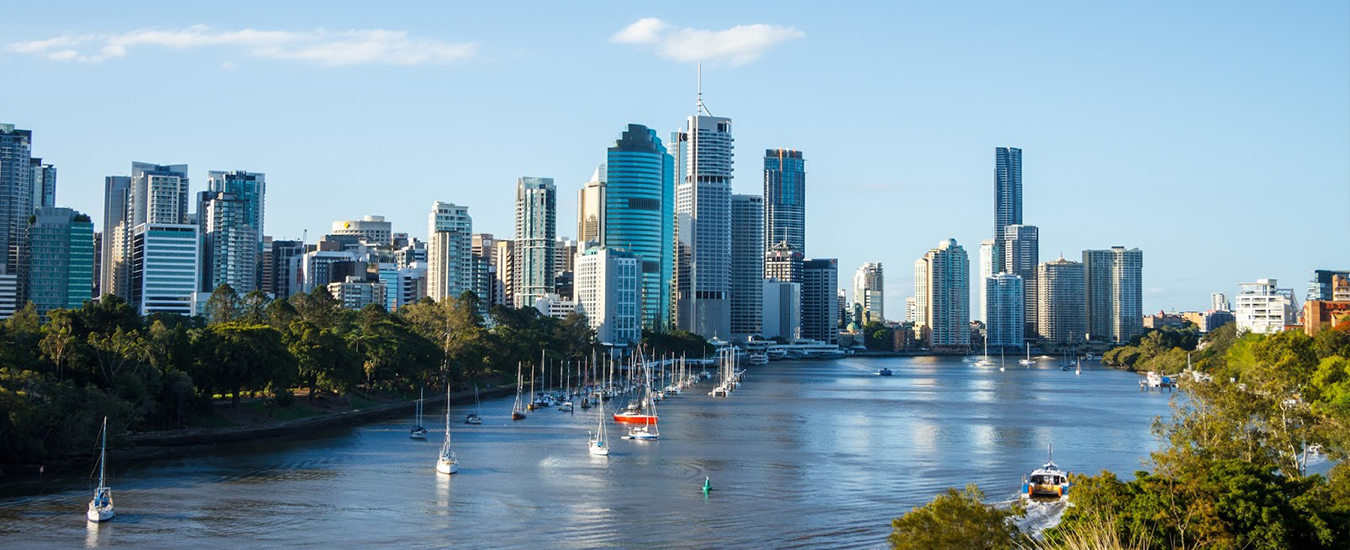
Elicited weak to strong positive emotions

The majority of respondents had a neutral response in terms of emotion, but the smaller subgroup had a strong positive emotional reaction. The community members in the smaller subgroup expressed pride and happiness as residents of the capital city depicted in the image.
“It’s Brisbane, the river, the city cat - which is one of the most positive things we have had in Brisbane for a long time…it’s such a lovely way to travel”
Somewhat relevant to the topic

The community members had a moderate response in terms of topic relevance. People understood that rainwater flows into the Brisbane River.
“The shots of the river I’ve moved back a little bit because it takes a bigger storm to affect the river than a small creek.”
“Brisbane River relevant to capture stormwater”
Somewhat to highly personally relevant

The group was split in terms of personal relevance, where just over half of community members ranked the images as somewhat relevant and the remaining community members ranked the images as highly personally relevant. This was tied to the familiarity of the image.
“Because I’m some-one who has lived in Brisbane my whole life, I love Brisbane, I think it’s a beautiful city at night, and that’s a really lovely photo of it”
Recommendations for use:
- Use an image that includes people in it to further boost the personal relevance of your message.
- Explain the link between the image and stormwater management.
Interested in this solution?
We partner with small and large companies, government and industry in Australia and around the world.